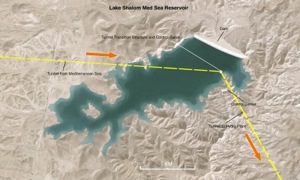In the 1960s, coinciding with population increases, great amounts of water from the water system we know as the Jordan River began to be drained off for irrigation and overall water needs. The Jordan River is also the main feed for the Dead Sea. With reduced water volumes, the Dead Sea levels are lowering at an increasing rate. Without a continual supply of water, the Dead Sea began exhibiting extraordinary and detrimental ramifications. To perceive the cause and effect, one must understand the geological process that distinguishes this body of water, unequaled by any other body of water in the world.
The seawaters are mineral rich that became an extraordinary popular resort of sorts for sovereigns and provincials alike becoming soothed by the sea’s invigorating waters throughout history as a natural spa. It has also been a source for people worldwide that purchase Dead Sea salts.
Alike to a domino effect, because the continual siphoning of the Jordon River, the river loses volume. This results in the Jordon not being able to be a continual source of water for the Dead Sea and so because of the high demand for the water the Dead Sea lowers. Like any body of water, if it lowers, water tables are affected by degenerating and because of this, the populace around the Sea loses or becomes limited to water usage. When the water tables lower wells begin drying up and likewise the local more diminutive lakes and streams follow suit. To add salt to the wound, so to speak, hydroelectric dams begin loosing potency in supplying energy to the populace. It is estimated that the world’s saltiest body of water will dry out by 2050.
It is understandable why the situation of the Dead Sea is catastrophic in nature. The population is increasing and water will be even more of a demand and it is highly doubtful that this part of the equation will change and the water consumption will continue but also increase. The water ministry estimates Jordan, whereas 92 % of the country is desert, will require 1.6 billion cubic meters of water a year to satisfy its needs by 2015. That is taking into consideration that the population of 6.8 million is raising by approximately 3.5 percent per year.
When humankind unite and form bonds of cooperation anything can be done. In 2005 Jordon, Palestinian Authority, and Israel agreed to combine efforts by signed agreement to study the leading question for a solution. Obviously, the resolution involved acquiring more water to counterbalance the insufficiency of the Jordon River. The agreed solution was to pipe in waters from the Red Sea and the Mediterranean to replenish the Dead Sea, a monumental undertaking for humanity. Not only would this project fulfill water requirements but open opportunity to expand hydroelectric power increasing the magnitude of national power grids.
As with any monolithic expanse of this nature, there is a concern for environmental transmutations upsetting the natural balance of the areas affected. Because of the high salination of the Dead Sea, there is a concern that this project could affect the natural balance by diluting the waters. You may conceptualize that this would be beneficial but you need to take into consideration the micro-evolutionary ramifications of a natural system. The Dead Sea and everything living within and the influences of the sea to the surrounding coastlands depend upon and has evolved dependency upon the present chemistry of the waters. In summation, the over-saturation of seawater could countermine the Dead Sea’s delicate ecosystem.
The Red Sea to Dead Sea channel would travel through Jordan costing around $10 billion, imparting up to 2 billion cubic meters of water a year according to reports. This type of project is nothing new for undertakings of this scope have been built in the United States, South Africa and Brazil. As of the writing of this report, the government has sanctioned the project after arduous years of geological, political, technical, and economic studies and that the $980 million program is projected to furnish Jordan with 3.5 billion cubic feet of water on a yearly basis.
It is evident that this project is a necessity to all areas affected and with provident provisions not only brings the much-needed water to the region but possibly bring about peaceful coexistence between countries by means of collaboration.

